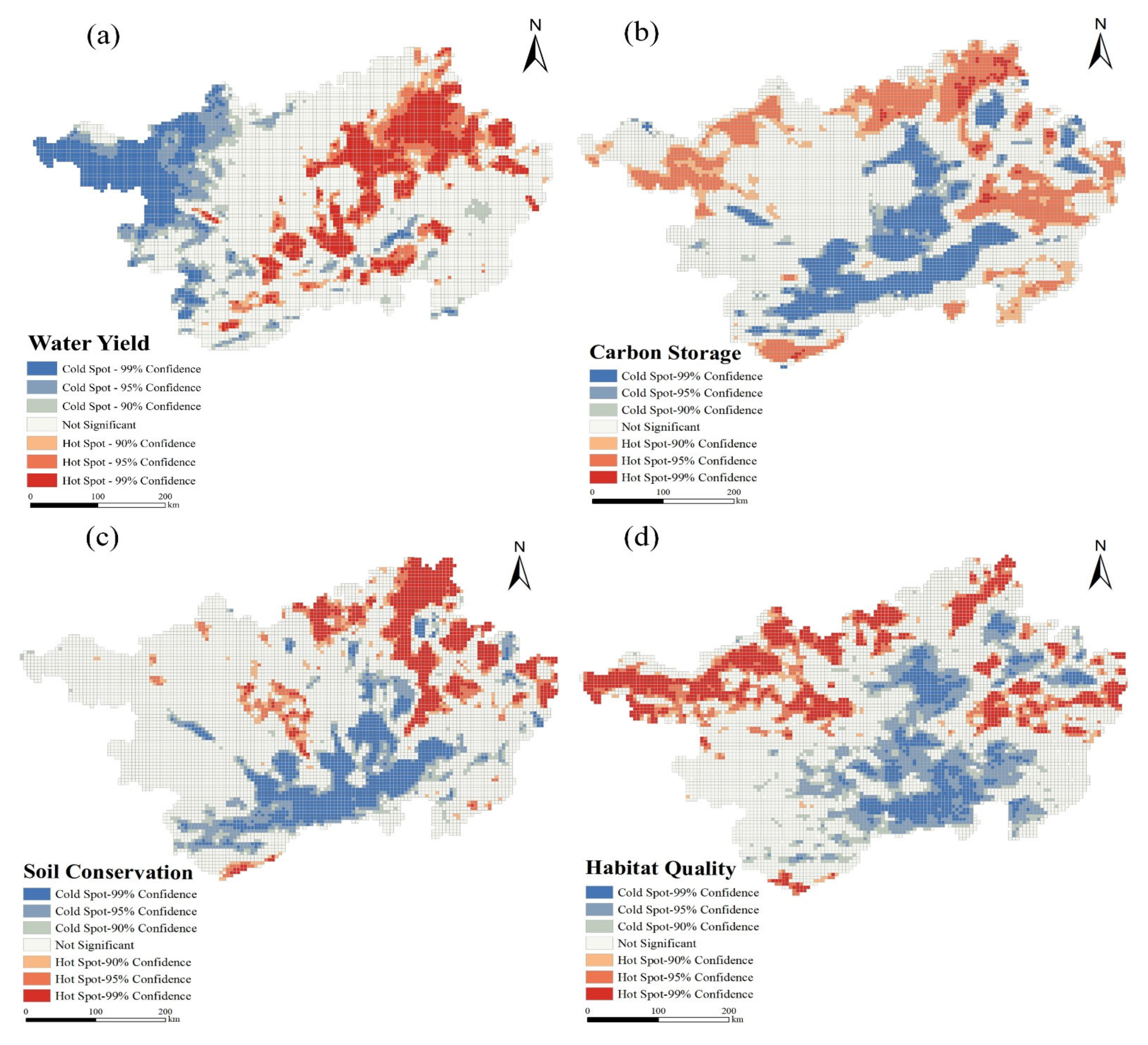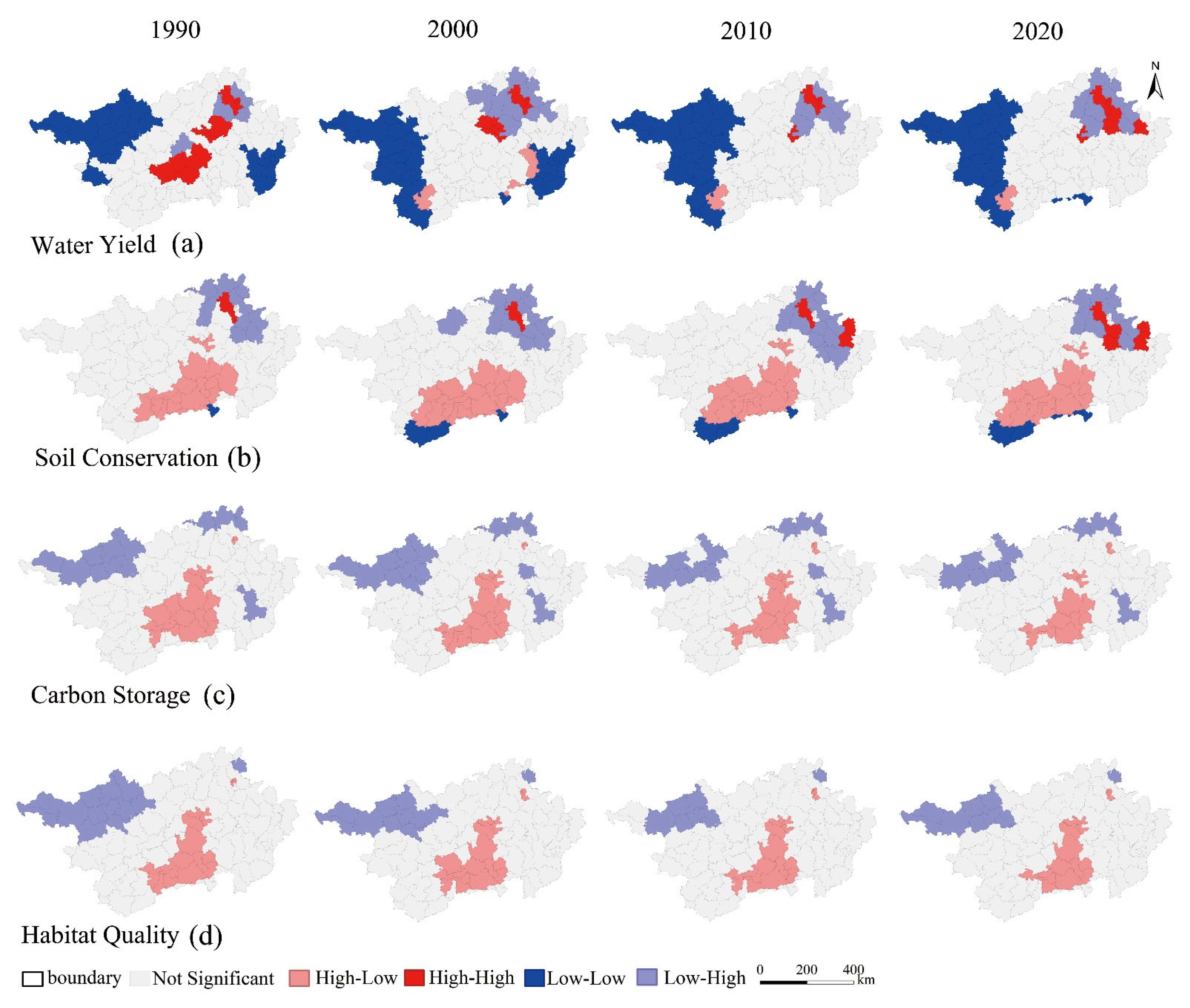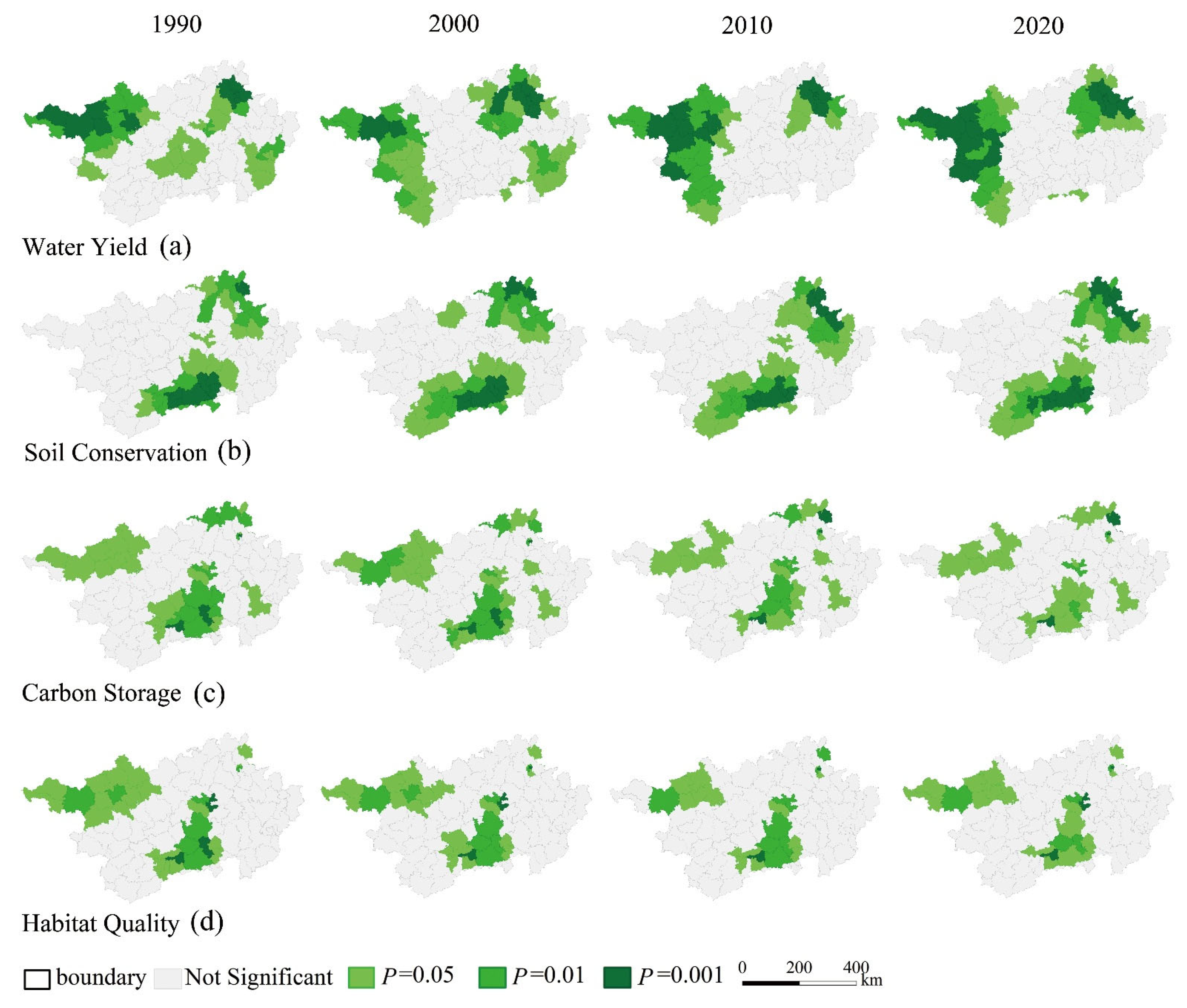Effects of Land Use Change on Ecosystem Service Dynamics in the Guangxi Xijiang River Basin
Abstract
1. Introduction
2. Materials and Methods
2.1. Research Framework
2.2. Study Area
2.3. Acquisition of Data and Preprocessing Procedures
2.3.1. Land Use and Cover Dataset
2.3.2. Meteorological Data
2.3.3. Relevant Supplementary Data
2.3.4. Data Preprocessing
2.4. Research Methodology
2.4.1. Investigation into the Dynamics of Land Use
Transfer Matrix
Land Use Intensity
2.4.2. Quantitative Assessment of Ecosystem Services
2.4.3. Cold and Hot Spot Analysis
2.4.4. Bivariate Spatial Autocorrelation Analysis Method
3. Results
3.1. Spatiotemporal Patterns and Variation in Land Use in Guangxi Xijiang River Basin
3.2. Spatiotemporal Variations in Ecosystem Service Functions
3.3. The Interrelationship Between Land Use Patterns and Ecosystem Services
3.3.1. Effects of Different Land Use Types on Ecosystem Service Supply
3.3.2. The Influence of the Composite Index for Land Use Degree on Ecosystem Services
4. Discussion
4.1. The Integration of Land Use and Ecosystem Services Has Important Implications for Further Research
4.2. The Influence Exerted by Land Use Transition on Ecosystem Services
4.3. Integrated Management of the Xijiang River Basin Based on the Relationship Between Ecosystem Services and Land Use
4.4. Limitations and Outlook
5. Conclusions
- (1)
- Throughout the 1990–2020 period, cropland, forest, and shrubland served as the primary land use types across the Guangxi Xijiang River Basin, accounting for 98% of the study area’s total extent and constituting the matrix of the surface cover landscape. The cropland, forest, water, barren, and impervious areas increased by 0.18%, 1.28%, 14.9%, 636.54%, and 208.03%, respectively, while shrub and grassland areas decreased by 43.02% and 80.61%, respectively. During the study period, wetland did not transfer to or from other land types, and the remaining seven land use types showed mutual transfer, mainly between cropland and forest, as well as between shrub and forest.
- (2)
- Since 1990, the overall trends of various ecosystem services have been downward. The ecosystem services of water yield, habitat quality, carbon storage and soil conservation have decreased by 13.38%, 9.75%, 7.43% and 10.77%, respectively. Across the Guangxi Xijiang River Basin, areas with high values of the water yield ecosystem service were primarily concentrated in the southwest–northeast direction. The northeast and eastern parts of the region contained high-capacity areas for both soil conservation and carbon storage. Furthermore, territories exhibiting elevated habitat quality service levels were predominantly distributed across the northwestern and eastern sectors.
- (3)
- Over the 30-year period, cropland, grassland, and impervious surfaces contributed substantially to the water yield ecosystem service. Wetland, shrub, and forest areas made high contribution to soil conservation and habitat quality. Forest and grassland exhibited high contributions to carbon storage. Water bodies demonstrated limited capacity to contribute to both water yield and soil conservation. Impervious surfaces provided limited contributions to habitat quality, carbon storage and soil conservation. Forest land, shrubland, and grassland exhibited synergistic relationships with multiple ecosystem services, while impervious surfaces demonstrated trade-offs with soil retention, carbon storage, and habitat quality.
Supplementary Materials
Author Contributions
Funding
Institutional Review Board Statement
Informed Consent Statement
Data Availability Statement
Acknowledgments
Conflicts of Interest
References
- Fu, B.; Yu, D.; Lv, N. An indicator system for biodiversity and ecosystem services evaluation in China. Acta Ecol. Sin. 2017, 37, 341–348. [Google Scholar] [CrossRef]
- Xie, G.; Lu, C.; Xiao, Y.; Zheng, D. The Economic Evaluation of Grassland Ecosystem Services in Qinghai-Tibet Plateau. Mt. Res. 2003, 21, 50–55. [Google Scholar] [CrossRef]
- Ke, L.; Jiang, Q.; Lu, Y.; Zhang, S.; Lei, N.; Yin, C.; Wang, Q.; Gai, M. Coupling analysis of resident well-being and ecosystem services under sustainable development goals: A case study of China’s coastal regions. Ecol. Indic. 2025, 179, 114234. [Google Scholar] [CrossRef]
- Wang, J.; Sun, Y.; Zhao, C.; Yang, Z.; Peng, J. Understanding the evolution of relationships among natural resource, social economy, and eco-environment. Geol. Bull. China 2024, 43, 1289–1296. [Google Scholar]
- You, G.; Wang, P.; Cao, J.; Hu, Y. Analysis of Spatial-temporal Evolution and Coupling Effects of LandUse and Ecosystem Services in a Resource-based City. J. Southwest For. Univ. (Nat. Sci.) 2025, 45, 117–127. [Google Scholar] [CrossRef]
- Gu, J.; Ren, J. Evaluation of Ecosystem Services Review based on Bibliometrics of CiteSpace. J. Hebei Univ. Environ. Eng. 2017, 27, 26–29+66. [Google Scholar] [CrossRef]
- Yuan, Z.; Wan, R. A review on the methods of ecosystem service assessment. Ecol. Sci. 2019, 38, 210–219. [Google Scholar] [CrossRef]
- Guo, Z.; Liu, Y.; Zhang, L.; Feng, C.; Chen, Y. Research progress and prospect of ecosystem services. J. Environ. Eng. Technol. 2022, 12, 928–936. [Google Scholar] [CrossRef]
- Dashtbozorgi, F.; Hedayatiaghmashhadi, A.; Dashtbozorgi, A.; Ruiz–Agudelo, C.A.; Fürst, C.; Cirella, G.T.; Naderi, M. Ecosystem services valuation using InVEST modeling: Case from southern Iranian mangrove forests. Reg. Stud. Mar. Sci. 2023, 60, 102813. [Google Scholar] [CrossRef]
- Tian, Y.; Xu, D.; Song, J.; Guo, J.; You, X.; Jiang, Y. Impacts of land use changes on ecosystem services at different elevations in an ecological function area, northern China. Ecol. Indic. 2022, 140, 109003. [Google Scholar] [CrossRef]
- Ouyang, X.; Tang, L.; Wei, X.; Li, Y. Spatial interaction between urbanization and ecosystem services in Chinese urban agglomerations. Land Use Policy 2021, 109, 105587. [Google Scholar] [CrossRef]
- Chen, L.; Zhang, A.; Wen, L. Complex interactions of ecosystem services and their dynamic changes in response to land-use conflicts—A network analysis in the Yangtze River Economic Belt, China. Land Use Policy 2025, 155, 107582. [Google Scholar] [CrossRef]
- Xun, R.; Zhou, Z.; Xu, Y.; Lu, Z. Spatial and Temporal Changes in Ecological Service Functions in Hunan Province Based on Land Use Change. Land Resour. Her. 2024, 21, 93–101. [Google Scholar] [CrossRef]
- Chang, Y.; Gao, J.; Xie, Z.; Zhang, T.; Yu, X. Spatiotemporal evolution and spatial correlation of habitat quality and landscape pattern over Beijing-Tianjin-Hebei region. China Environ. Sci. 2021, 41, 848–859. [Google Scholar] [CrossRef]
- Liu, L.; Jiang, K.; Hu, Z.; Feng, H. Response characteristics of ecosystem services values in territorial space development of Xiong′an New Area. Acta Ecol. Sin. 2022, 42, 2098–2111. [Google Scholar] [CrossRef]
- Liu, J.; Jiang, C.; Bai, Y.; Liu, E. The Research Progress of Ecosystem Service. For. Sci. Technol. 2023, 68–71. [Google Scholar] [CrossRef]
- Zhao, Y.; Su, F. Spatio-temporal dynamic characteristics of the ecosystem service values under differential economic growth:A case study of the Pearl River-West River Economic Belt. J. Nat. Resour. 2022, 37, 1782–1798. [Google Scholar] [CrossRef]
- Li, Y.; Geng, H.; Wu, L.; Luo, G.; Chen, F. Ecosystem Service Functions of a Typical Karst Urban Basin based on Land Use Change. J. Resour. Ecol. 2024, 15, 1–14. [Google Scholar] [CrossRef]
- Fu, B.; Huang, G.; Zhang, H.o.; Zhang, J. Strengthening ecological protection and green development in Pearl River Basin to support construction of Guangdong-Hong Kong-Macao Greater Bay Area. Bull. Chin. Acad. Sci. 2023, 38, 1440–1446. [Google Scholar] [CrossRef]
- Zhang, C.; Liu, J.; Hu, B.; Chen, X. Spatial pattern and its influencing factors of water conservation services in Xijiang River Basin, Guangxi. J. Zhejiang AF Univ. 2022, 39, 1104–1113. [Google Scholar] [CrossRef]
- Yang, J.; Huang, X. The 30m annual land cover dataset and its dynamics in China from 1990 to 2019. Earth Syst. Sci. Data 2021, 13, 3907–3925. [Google Scholar] [CrossRef]
- Cheng, Y.; Chen, Y. Spatial and Temporal Characteristics of Land Use Changes in the Yellow River Basin from 1990 to 2021 and Future Predictions. Land 2024, 13, 1510. [Google Scholar] [CrossRef]
- Ma, S.; Shi, M.; Yang, G.; Xu, X.; Yin, J. Analysis on Spatiotemporal Change of Land Use Based on GIS Technology—Taking Xinjiang Tarim Basin as an Example. Res. Soil Water Conserv. 2013, 20, 177–181. [Google Scholar]
- Valencia Torres, A.; Tiwari, C.; Atkinson, S.F. Progress in ecosystem services research: A guide for scholars and practitioners. Ecosyst. Serv. 2021, 49, 101267. [Google Scholar] [CrossRef]
- Pang, C.; Wen, Q.; Ding, J.; Wu, X.; Shi, L. Ecosystem services and their trade-offs and synergies in the upper reaches of the Yellow River basin. Acta Ecol. Sin. 2024, 44, 5003–5013. [Google Scholar] [CrossRef]
- Qiao, X.; Li, Z.; Lin, J.; Wang, H.; Zheng, S.; Yang, S. Assessing current and future soil erosion under changing land use based on InVEST and FLUS models in the Yihe River Basin, North China. Int. Soil Water Conserv. Res. 2024, 12, 298–312. [Google Scholar] [CrossRef]
- Zhu, Y.; Ma, B.; Hu, H.; Ding, D.; Zhou, H.; Liu, J.; Liu, J.; Lin, Z. Analysis and prediction of spatiotemporal carbon storage changes in the Taihu Lake Basin in Jiangsu Province based on PLUS and InVEST model. Trees For. People 2025, 21, 100916. [Google Scholar] [CrossRef]
- Wei, Q.; Abudureheman, M.; Halike, A.; Yao, K.; Yao, L.; Tang, H.; Tuheti, B. Temporal and spatial variation analysis of habitat quality on the PLUS-InVEST model for Ebinur Lake Basin, China. Ecol. Indic. 2022, 145, 109632. [Google Scholar] [CrossRef]
- Chang, J.; Wu, Z.; Li, Q.; Liang, H.; Du, Z.; Lei, T.; Sun, B. Spatiotemporal Distribution of Ecosystem Services and Analysis of Cold and Hot Spots in Beijing-Tianjin Sandstorm Source Region. J. Soil Water Conserv. 2024, 38, 216–226. [Google Scholar] [CrossRef]
- Min, J.; Liiu, X.; Xiao, Y.; Li, H.; Luo, X.; Wang, R.; Xing, L.; Wang, C.; Zhao, H. Spatial and temporal distribution of ecosystem services and trade-offs in the Yangtze River Delta. Geol. Bull. China 2025, 44, 136–149. [Google Scholar] [CrossRef]
- Almeida, B.; Monteiro, L.; Tiengo, R.; Gil, A.; Cabral, P. Spatially explicit assessment of carbon storage and sequestration in forest ecosystems. Remote Sens. Appl.: Soc. Environ. 2025, 38, 101544. [Google Scholar] [CrossRef]
- Li, Y.; Luo, Y.; Liu, G.; Ouyang, Z.; Zheng, H. Effects of land use change on ecosystem services: A case study in Miyun reservoir watershed. Acta Ecol. Sin. 2013, 33, 726–736. [Google Scholar] [CrossRef]
- Ke, Q.; Zhou, Q.; Zhuang, B.; Sun, C. Construction of ecological security pattern in Guangdong-Hong Kong-Macao Greater Bay Area based on the balance of ecosystem services supply and demand. Acta Ecol. Sin. 2024, 44, 1765–1779. [Google Scholar] [CrossRef]
- Hu, J.; Wang, J.; Zhou, Z.; Li, H. Effects of land use changes on ecosystem service values in urban area of Guilin city. J. Cent. South Univ. For. Technol. 2012, 32, 89–93. [Google Scholar] [CrossRef]
- Li, L.; Deng, L.; Wu, R. Effects of land use changes on ecosystem service values: A case study of Liuzhou city. J. Cent. South Univ. For. Technol. 2013, 33, 102–106. [Google Scholar] [CrossRef]
- He, Y.; Tang, X.; Dai, J. Land-use structure optimization for the Lijiang River basin ecosystem service value maximization. Acta Ecol. Sin. 2021, 41, 5214–5222. [Google Scholar] [CrossRef]
- Tang, X.; Liu, M.; Wu, Y.; Huai, H.; Liu, X. Impacts of comprehensive consolidation and ecological restoration of land space on ecosystem service value. Acta Ecol. Sin. 2024, 44, 5974–5984. [Google Scholar] [CrossRef]
- Huang, X.; Yan, Z.; Hu, B.; Yan, Q.; Peng, D.; Sheng, K. Spatial autocorrelation analysis study of land use and ecosystem service value in karst area:A case of Baise City in Guangxi. Hubei Agric. Sci. 2023, 62, 44–53. [Google Scholar] [CrossRef]
- Chen, P.; Tang, H.; Dong, Y.; Jiang, P.; Liu, Y. Payment Preference and Latent Class Identification of Residents for Ecological Compensation in the Xijiang River Basin. J. Hydroecology 2023, 44, 9–16. [Google Scholar] [CrossRef]
- Wang, Y.; Ma, J. Effects of land use change on ecosystem services value in Guangxi section of the Pearl River-West River Economic Belt at the county scale. Acta Ecol. Sin. 2020, 40, 7826–7839. [Google Scholar] [CrossRef]
- Lei, J.; Chen, z.; Wu, T.; Li, Y.; Yang, Q.; Chen, X. Spatial autocorrelation pattern analysis of land use and the value of ecosystem services in northeast Hainan island. Acta Ecol. Sin. 2019, 39, 2366–2377. [Google Scholar] [CrossRef]
- Jin, X.; Jin, Y.; Mao, X. Ecological risk assessment of cities on the Tibetan Plateau based on land use/land cover changes—Case study of Delingha City. Ecol. Indic. 2019, 101, 185–191. [Google Scholar] [CrossRef]
- Smith, M.S.; Cook, C.; Sokona, Y.; Elmqvist, T.; Fukushi, K.; Broadgate, W.; Jarzebski, M.P. Advancing sustainability science for the SDGs. Sustain. Sci. 2018, 13, 1483–1487. [Google Scholar] [CrossRef]
- Zhu, L.; Wu, Z.; Huang, X. Exploring the relationship between ecosystem services and sustainable development goals in Guangdong province, China. Ecol. Indic. 2024, 169, 112907. [Google Scholar] [CrossRef]
- Qiu, H.; Hu, B.; Zhang, Z. Impacts of land use change on ecosystem service value based on SDGs report--Taking Guangxi as an example. Ecol. Indic. 2021, 133, 108366. [Google Scholar] [CrossRef]
- Wang, Y.; Gong, J.; Zhu, Y. Integrating social-ecological system into watershed ecosystem services management: A case study of the Jialing River Basin, China. Ecol. Indic. 2024, 160, 111781. [Google Scholar] [CrossRef]
- Hu, B. Geography of Guangxi; Jingai, W., Ed.; Beijing Normal University Publishing Group: Beijing, China, 2011. [Google Scholar]
- Zhang, X.; Zhou, Y.; He, W.; Ju, W.; Liu, Y.; Bi, W.; Cheng, N.; Wei, X. Land cover change instead of solar radiation change dominates the forest GPP increase during the recent phase of the Shelterbelt Program for Pearl River. Ecol. Indic. 2022, 136, 108664. [Google Scholar] [CrossRef]
- Yang, Y.; Li, M.; Feng, X.; Yan, H.; Su, M.; Wu, M. Spatiotemporal variation of essential ecosystem services and their trade-off/synergy along with rapid urbanization in the Lower Pearl River Basin, China. Ecol. Indic. 2021, 133, 108439. [Google Scholar] [CrossRef]
- Zhou, R.; Lin, M.; Gong, J.; Wu, Z. Spatiotemporal heterogeneity and influencing mechanism of ecosystem services in the Pearl River Delta from the perspective of LUCC. J. Geogr. Sci. 2019, 29, 831–845. [Google Scholar] [CrossRef]
- Jiang, Z.; Wu, H.; Xu, Z.; Shen, F.; Jia, N.; Huang, J.; Lin, A. Optimizing land use spatial patterns to balance urban development and resource-environmental constraints: A case study of China’s Central Plains Urban Agglomeration. J. Environ. Manag. 2025, 380, 125173. [Google Scholar] [CrossRef] [PubMed]
- Wang, S.; Xiang, Y.; Gao, F.; Zhao, L.; Luo, X.; Hou, M.; Bian, S. Spatiotemporal evolution characteristics of ecosystem services under the influence of natural and anthropogenic factors:a case study of the Guanzhong Plain urban agglomeration. J. Xi’an Univ. Technol. 2025, 41, 227–236. [Google Scholar] [CrossRef]
- Huang, A.; Xu, Y.; Sun, P.; Zhou, G.; Liu, C.; Lu, L.; Xiang, Y.; Wang, H. Land use/land cover changes and its impact on ecosystem services in ecologically fragile zone: A case study of Zhangjiakou City, Hebei Province, China. Ecol. Indic. 2019, 104, 604–614. [Google Scholar] [CrossRef]
- Xie, Y.; Zhang, S.; Lin, B.; Zhao, Y.; Hu, B. Spatial zoning for land ecological consolidation in Guangxi based on the ecosystem services supply and demand. J. Nat. Resour. 2020, 35, 217–229. [Google Scholar] [CrossRef]
- Agudelo, C.A.R.; Bustos, S.L.H.; Moreno, C.A.P. Modeling interactions among multiple ecosystem services. A critical review. Ecol. Model. 2020, 429, 109103. [Google Scholar] [CrossRef]










| Water Yield | 1990 | 2000 | 2010 | 2020 | Mean Value |
|---|---|---|---|---|---|
| Moran’s I | 0.5333 | 0.3880 | 0.4360 | 0.4038 | 0.44 |
| p-value | 0.001 | 0.001 | 0.001 | 0.001 | |
| Z-value | 8.8612 | 7.0395 | 7.8275 | 7.4999 | |
| Soil conservation | 1990 | 2000 | 2010 | 2020 | Mean value |
| Moran’s I | −0.4182 | −0.3811 | −0.3793 | −0.2726 | −0.36 |
| p-value | 0.001 | 0.001 | 0.001 | 0.001 | |
| Z-value | −7.2727 | −6.7500 | −6.6760 | −5.0252 | |
| Carbon storage | 1990 | 2000 | 2010 | 2020 | Mean value |
| Moran’s I | −0.6276 | −0.6357 | −0.6191 | −0.5888 | −0.62 |
| p-value | 0.001 | 0.001 | 0.001 | 0.001 | |
| Z-value | −9.5731 | −9.6283 | −9.4098 | −8.9514 | |
| Habitat quality | 1990 | 2000 | 2010 | 2020 | Mean value |
| Moran’s I | −0.4675 | −0.4681 | −0.4435 | −0.4399 | −0.45 |
| p-value | 0.001 | 0.001 | 0.001 | 0.001 | |
| Z-value | −7.8867 | −7.8492 | −7.4754 | −7.4908 |
Disclaimer/Publisher’s Note: The statements, opinions and data contained in all publications are solely those of the individual author(s) and contributor(s) and not of MDPI and/or the editor(s). MDPI and/or the editor(s) disclaim responsibility for any injury to people or property resulting from any ideas, methods, instructions or products referred to in the content. |
© 2025 by the authors. Licensee MDPI, Basel, Switzerland. This article is an open access article distributed under the terms and conditions of the Creative Commons Attribution (CC BY) license (https://creativecommons.org/licenses/by/4.0/).
Share and Cite
Yan, Y.; Jiajiao, R.; Yanhong, F. Effects of Land Use Change on Ecosystem Service Dynamics in the Guangxi Xijiang River Basin. Sustainability 2025, 17, 10558. https://doi.org/10.3390/su172310558
Yan Y, Jiajiao R, Yanhong F. Effects of Land Use Change on Ecosystem Service Dynamics in the Guangxi Xijiang River Basin. Sustainability. 2025; 17(23):10558. https://doi.org/10.3390/su172310558
Chicago/Turabian StyleYan, Yan, Rao Jiajiao, and Fan Yanhong. 2025. "Effects of Land Use Change on Ecosystem Service Dynamics in the Guangxi Xijiang River Basin" Sustainability 17, no. 23: 10558. https://doi.org/10.3390/su172310558
APA StyleYan, Y., Jiajiao, R., & Yanhong, F. (2025). Effects of Land Use Change on Ecosystem Service Dynamics in the Guangxi Xijiang River Basin. Sustainability, 17(23), 10558. https://doi.org/10.3390/su172310558






